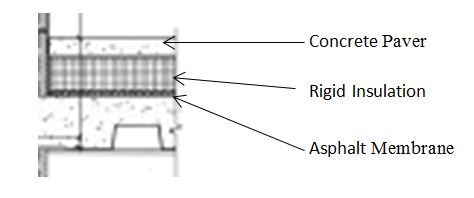Building Statistics
Building Name: |
Hunter's Point South Intermediate School & High School |
|
Project Team: |
| Owner: |
New York City Department of Education |
| Location: |
1-50 51st Avenue
Long Island City, NY 11101 |
Represented by: |
New York City School Construction Authority |
| Building Occupant: |
New York City School District (PS 287 Queens) |
Architect: |
FXFOWLE ARCHITECTS, PC |
| Occupancy Type: |
E (Educational) |
General Contractor/CM: |
SKANSKA |
| Size: |
153,769 SF |
Structural Engineer: |
YSREAL A. SEINUK, PC |
| Building Height: |
73' |
MEP/Fire Protection: |
KALLEN & LEMELSON, LLP |
| Number of Stories: |
5 stories, no cellar, mechanical penthouse |
Site-Civil/Landscape/Geotechnical: |
LANGAN ENGINEERING AND ENVIRONMENTAL SERVICE |
| Construction Dates: |
January 10, 2011 to October 7, 2013 |
Acoustical/AV Consultant: |
CERAMI & ASSOCIATES, INC. |
| Cost: |
$61,098,000 construction cost |
Lighting Designer: |
TILLOTSON DESIGN ASSOCIATES |
| Delivery Method: |
Lump Sum Bid |
Elevator Consultant: |
VAN DEUSEN & ASSOCIATES |
| |
Architecture |
The Hunter's Point South Intermediate School & High School is a public school for grades 5 through 12 serving the PS 287 Queens School district. Hunter's Point is a five story school that will house over 1,000 students. It consists of 26 classrooms, 8 special education classrooms, library, gym, assembly space, cafeteria with open terrace seating, kitchen, and support spaces. It is a part of the Hunter's Point South Project, a redevelopment of the 30 acre Queens area to become a more sustainable, middle income urban community along the waterfront park. This redevelopment in Queens also includes residential housing, apartments, retail space, community/cultural facilities, parking, and a new 11 acre waterfront park.
The architecture of Hunter's Point South Intermediate School & High School was design intended to fit in with the new vibrant, urban community. The school is of modern architectural design. Its cubicle shape is transformed by the cantilevers and triangular window designs as well as the building materials. The facade exterior is largely dominated by grey face brick but there is also slate veneer, perforated steel panels, and four aluminum curtain window walls.
|
Major Codes
New York State Codes:
- 2008 New York City Building Code
- 2007 Building Code
- 2007 Mechanical Code
- 2007 Plumbing Code
- 2007 Fire Code
- 2007 Energy Conservation Construction Code
- 2007 Fuel Gas Code
2005 National Electric Code
New York City Green Schools Guide |
|
 |
| |
 |
Zoning
Hunter's Point South Intermediate School & High School is in the M1-4 zoning district. M1 is typically designated for light industrial buildings but with special permission, public facilities may also be constructed. Very little parking exists on site since parking is not required under M1-4.
Historical Requirements
No historical requirements exist.
|
| |
Building Enclosure |
Building Facade
The exterior facade of Hunter's Point South Intermediate School & High School is primarily dominated by 4"x4"x12" grey smooth modular bricks with 6" lightweight CMU backing. The entrances on the ground floor are encompassed by a 2" honed finished slate stone veneer also over 6" lightweight CMU. Windows along the ground floor are backed by perforated steel panels for safety precautions. An Insulated Translucent Sandwich Panel System (ITSPS) stretches upward from the first to second floor. The ITSPS is a 2-3/4" fiberglass system that allows for 15% light transmission and has a U factor of 0.28. Extensive curtain walls spanning multiple floors are used for the window wall system and are framed by 4mm thick aluminum composite, orange panels. The window wall glazing is 1" thick preassembled clear annealed float glass comprised of a 1/8" annealed exterior sheet, 60mil polyvinyl butyral interlayer, and 1/8" interior sheet with a low-e coating. Below Figures 1 and 2 show callouts of the different facade elements of Hunter's Point South School.
 |
Figure 1 - North Elevation from drawing A201
Figure 2 - South Elevation from drawing A203
Roofing
The typical roof structure for Hunter's Point South Intermediate School & High School is concrete on metal deck. On top of the concrete a 215mil fabric reinforced, rubberized asphalt membrane is applied. 4" rigid insulation then follows with a finished grid of 2' by 2' concrete pavers that are 2" thick. Below in Figure 3 is a detail of the roof assembly.
 |
Figure 3 - Roof Assembly from drawing A310 |
|
| |
Sustainability Features |
The New York City School Construction Authority enacted a NYC Green Schools Guide for schools designed after January 2007. The rules and regulations outlined in this document are based upon LEED requirements, some of which go above and beyond. Since Hunter's Point South School is required to meet the NYC Green Schools Guide, further effort to receive LEED certification has been neglected. However, the school house still has many sustainable features and design considerations. It utilizes local materials within 500 miles of the site as well as recycled steel. Finishing materials that emit low voc's have been given special attention. Other elements of the school include occupant sensors to control lighting, solar shading, and self-adjusting ventilation system.
|
| |
Mechanical |
Conditioned air is served to Hunter's Point South Intermediate School & High School via the six rooftop air handling units. Units 1, 2, and 3 are variable air volume (VAV) systems that service the classrooms, offices, corridors, and non-public spaces. Units 4, 5, and 6 are constant air volume (CAV) systems that serve the gymnasium, cafeteria/kitchen, and auditorium, respectively. All air handling units have variable frequency drives, wrap around heat pipes for dehumidification, and economizer controls. Preheat coils in the AHU's use a 35% propylene glycol-water mixture while the cooling coil utilizes a 30% propylene glycol-water mixture. This heat-transfer fluid has low toxicity and volatility. It poses little harm to humans in case of a leak.
Four natural gas fired, condensing boilers are used for Hunter's Point South School's heating needs. These boilers are located in the mechanical penthouse's boiler room. Each boiler can produce 1860 MBH worth of 35% propylene glycol-water mixture which is used for the AHU's, perimeter fin tube radiators, unit heaters, and cabinet heaters. All heating hot water and secondary pumps are located in the boiler room along with the hot and chilled water expansion tanks. Two 276 ton air cooled chillers with scroll compressors are also located on the roof. A 30% propylene glycol-water mixture is cooled by the R-410a refrigerant which is used for the AHU's cooling coils.
Cabinet and unit heaters are used to heat the building's entrances, locker rooms/showers, and stairwells. Split heat pumps are utilized in the telecom rooms on each floor, food storage, and elevator machine room. The outdoor section of each heat pump is located on the roof. Fin tubed radiators are used along the perimeter walls to heat the space in conjunction with AHU's. Upblast and mushroom fans are located on the roof where they exhaust air from the science lab's fume hoods and kitchen.
|
| |
Structural |
Hunter's Point South School sits on top of soils that range from grey silty sand to clay. Bedrock consisting of Gneiss begins 40 feet below the school. No basement exisits because the Queens-Midtown easement line (highway) runs under the site. A 12" 4000 psi slab on grade makes the bottom floor. This slab is supported by a system of grade and strap beams, 14" caissons, and steel H-piles.
The floor system for Hunter's Point South School is typcially a 3-1/4" thick, 3500 psi lightweight concrete slab on top of a 3" composite 18 gage galvanized metal deck. This 6-1/4" thick deck is then supported by a steel framing system. The cast in place concrete slabs are reinforced with #4 rebar that is spaced 12" in both directions. The gymnasium and auditorium have different flooring systems. The gymnasium uses acoustical metal deck while the auditorium uses a 16 gage deck.
The superstructure of Hunter's Point South School is comprised of steel. The columns are primarily W10 and the girders are W24 with W14 beams. The dimensions of spans vary. HSS and wide flange lateral truss bracing with moment connections are used for the lateral force resisting system. |
| |
Electrical |
The electrical distribution system of Hunter's Point South School is a radial system with 208Y/120V for the entire system. The single entry point comes into the Electrical Service Room - Room 117 along the north face of the building. Two switchboards are located in this room. MS1 (main switchboard 1) serves the mechanical systems while MS2 (main switchboard 2) serves the lights. MS1 and MS2 are 4000A and 2000A respectively.
Each floor has two side by side electric rooms which distribute conduit and wire to the floor. One room is dedicated to panelboards that are only connected to normal power. The other room has panelboards connected to the emergency generator. A 400 kW Diesel Generator is located in the first floor Emergency Power Room. Incase of a power outage, this generator will serve the critical loads of the building. |
| |
Lighting |
There are 46 different lighting fixtures that are used in Hunter's Point South School. Fluorescent lighting is typically used. The fluorescent lighting is comprised of 32 Watt linear fluorescents and 32 Watt compact fluorescents (CFL's). Other lights used include: incandescent, metal halide, ceramic metal halid, LED, and halogen. MR16 track and spotlights are utilized in the auditorium. The gymnasium uses high bay fixtures with T8 fluorescent lamps. Lighting occupancy sensors are used in the classrooms. Other spaces have timer controlled lighting with manual overrides for nonpublic spaces.
|
| |
Construction |
The project delivery method is a Lump Sum Bid with the client being represented by the New York City School Construction Authority. Construction began recently on January 10th, 2011 and is expected to be completed on October 7th, 2013.
Hunter's Point South School has no basement. This design consideration was based on a few reasons. The water table is roughly 7 feet below the school and an operating engineer would be needed for the dewatering pump (which is very costly). Dewatering this 35,000 square foot footprint for a basement would be a substantial cost. The water would also have to be treated prior to being returned to the city sewage system. Due to all of this and that enough space was found elsewhere in the building, a basement was not seen as a viable option. |
| |
Fire Protection |
The fire protection is a wet standpipe/sprinkler system with both concealed and upright sprinkler heads. The main fire pump is a 1000 gpm vertical split case pump. A centrifugal jockey pump sustains pressure in the pipes. Water for the sprinkler system is brought in through two 8" pipes to the Fire Pump/Plumbing/Lab Support Room on the first floor.
|
| |
Plumbing |
Domestic water is brought into the Fire Pump/Plumbing/Lab Support Room on the first floor of Hunter’s Point South School through a 4" service pipe. From there it is circulated to the Boiler Room on the roof by two 180 gpm booster pumps. The gas fired water heater produces potable hot water for the entire building which is stored in a 504 gallon tank with a 132 gallon expansion tank; all are also located in the Boiler Room. Two pumps in the Boiler Room circulate this hot water, one supplying the kitchen and the other supplying the rest of the building.
High pressure gas is used to serve the 4 boilers, water heater, kitchen equipment, and small burners located in the science classrooms. The gas is introduced to the building through a 4" service pipe to the Gas Room located on the first floor and exhausted through vents on the roof. A sump pump is located in the elevator pit in case of flooding. A 6" sanitary sewer line and two storm sewer pipes (8" and 10") are fed into Hunter’s Point South School underground to the first floor.
|
| |
Vertical Transportation |
Three stairwells and two elevators are used for circulation in Hunter's Point South School. The two main stairwells are located on north and south side of the school directly across from one another. They connect directly to the entrance lobbies. The third stairwell is on the east wing. All stairwells and elevators run from the first to fifth floor. The north stairwell extends one floor further up into the mechanical penthouse. Means of egress are located at the end of each of the two hallways on the first floor. For convenience, the two elevators are situated in the middle of the building at the crossing of the two hallways.
|
|